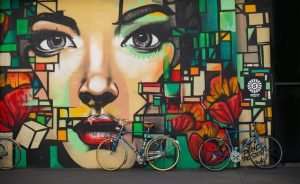Still life art is a difficult subject to photograph. The light levels are usually low, the lighting conditions usually harsh, and the subject is often small and delicate.
Getting a high-quality photo of your still life art is easier if you use a tripod and a remote shutter release. This eliminates camera shake, blurring the image.
You should also make sure that your camera has the ISO set as low as possible (ISO 100 or 200). This will capture more detail in your photos. Normally, you’ll want to use the lowest f-stop number possible on your lens (the smallest aperture) to capture as much light as possible.
The best time of day to shoot still life art is during the “magic hour” just before sunset. The sun won’t be directly overhead, but will cast soft shadows over your still life art and create beautiful light on it.
If you think about it, still life art is hard to photograph. What I mean by still life art are paintings and other objects not meant to be photographed, like a vase of flowers or a bowl of fruit.
Tuning the light in a room for still life art is easy. You can do it with just two light sources: a spotlight on the object and a fill light on the background. A fill light is just a broad source of soft light that spills over onto the background, filling it in with even illumination.
The big problem with photographing still life art is shadows. Both natural shadows (caused by blocking light) and man-made shadows (caused by moving lights). This means that you don’t want harsh shadows on your photo. Instead, you want soft shadows that will blend into the background.
Another problem with photographing still life art is flare from specular highlights. Specular highlights are reflections from smooth surfaces like glossy plastic and shiny metallic paint. The main way to deal with specular highlights is to avoid putting them under direct lighting, but this isn’t always possible. If you can’t avoid putting a highlight under direct lighting, then try using window light; it’s softer than spotlights or flashlights for reasons that are
Still life art photography is the art of taking pictures of objects that are inanimate or immobile. Still life photos are often used in commercial and editorial settings as a way to highlight or focus on a product. These types of photographs are also known as “product” photography, which can be used for advertising, catalogs, and more.
Treat your still life photos like you would any other type of photographic subject. It’s important to not just take a snapshot but to consider the way you light, compose and edit your image. In this post we’ll go over some tips for photographing still life art that will help take your images from snapshots to professional quality photographs.*
Still Life Art Photography Tips*
Use Natural Light – You want to use indirect light whenever possible to get soft shadows and eliminate harsh shadows from areas where you don’t want detail. You should make sure your lighting is coming from the side so it will create nice highlights and shading on your object. You can also use window light if it’s not too harsh.
I came to learn that still life photography is a highly specialized field, much more than I could have guessed. There are specialized lighting techniques, specialized camera equipment, and specific software used to process the images. All the still life photographers I spoke with emphasized that a mastery of these tools was necessary for creating high quality images. This is because creating a still life photo requires a good deal of technical knowledge about how to properly capture the objects being photographed.
This means that there is a lot of overlap between skills needed for still life photography and skills needed for other forms of photography. However, not every photographer will benefit from this overlap. Still life photographers need to have a very specific set of skills in order to create their work.
In a nutshell, the easiest way to take good photos of art is to use a digital camera with manual settings and some kind of external light.
Manual Settings. Digital cameras have “manual” settings. They are not really what you would call “manual” in the traditional sense; you don’t need to understand exposure times or aperture ratings or anything like that. But they allow you to control shutter speed and f-stop, which are the important things. Most digital cameras now have automatic modes too, but if you want to take high-quality pictures of artwork, you need to turn them off.
New Light Sources. Obviously if you are going to take pictures of art, you’re going to need some light. Natural light is great, but only if you have a window with lots of daylight available. If it’s overcast outside or at night, forget it. You’ll need artificial light sources. The ideal sources are flashlights or lamps with daylight-balanced bulbs (5500K).
Art is an art form, a creative process or discipline whereby the artist produces tangible or intangible objects that can be shared with others. The word is derived from the Latin word ars, which means skill.
The word “art” refers to all the products of human creativity, including fine art, applied art and industrial design.
Still life art is a highly specialized form of photography that involves arranging everyday objects into a composition that evokes feelings and emotions in the viewer. Still life artists work in a variety of media, including painting, drawing and sculpture. Some are professionals who earn income from their artwork; others are part-time amateurs combining photography as a hobby with another profession.
The best way to learn photography is to photograph, so I started taking pictures. I posted them on Flickr, and got some great feedback from other photographers. But there was one thing that kept coming up: I needed to improve my lighting.
I learned about the “golden ratio” for lighting, where you have light on either side of the object that mimics the shape of a rectangle with the same proportions as the object itself. I tried it out, and it didn’t seem to do anything for me.
I asked around online and got a lot of conflicting information. It seemed like everyone had a different system they liked. Some liked gold reflectors, others silver. Some people said natural light was best; others said flash was more versatile.
The truth is, I didn’t know how to use my lights! Sure, I could fiddle with them enough to get a decent picture if I posed everything just right and took 20 shots until one looked good. But it’s not very satisfying to spend all day shooting one thing and still not have anything you’re happy with.


